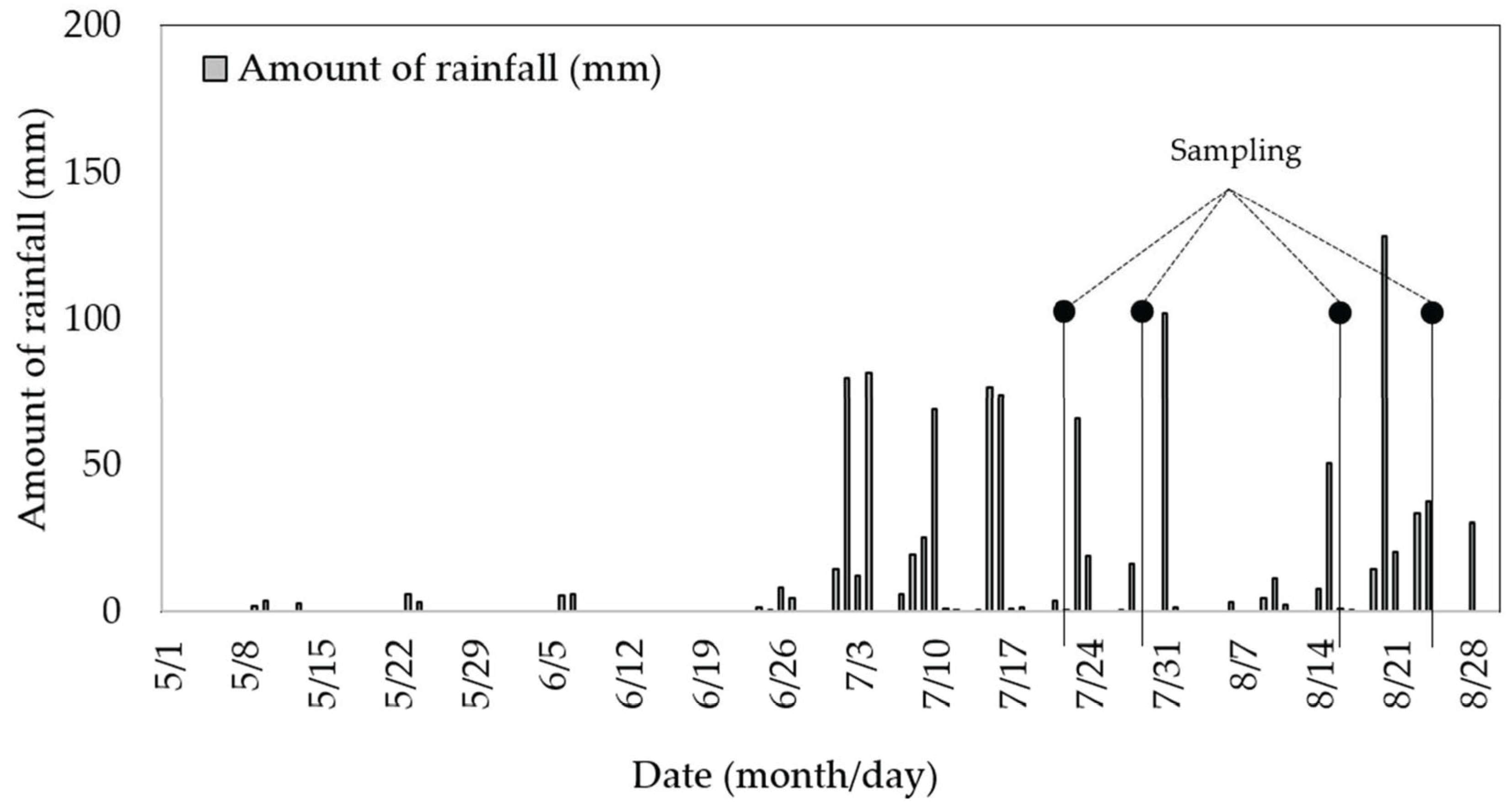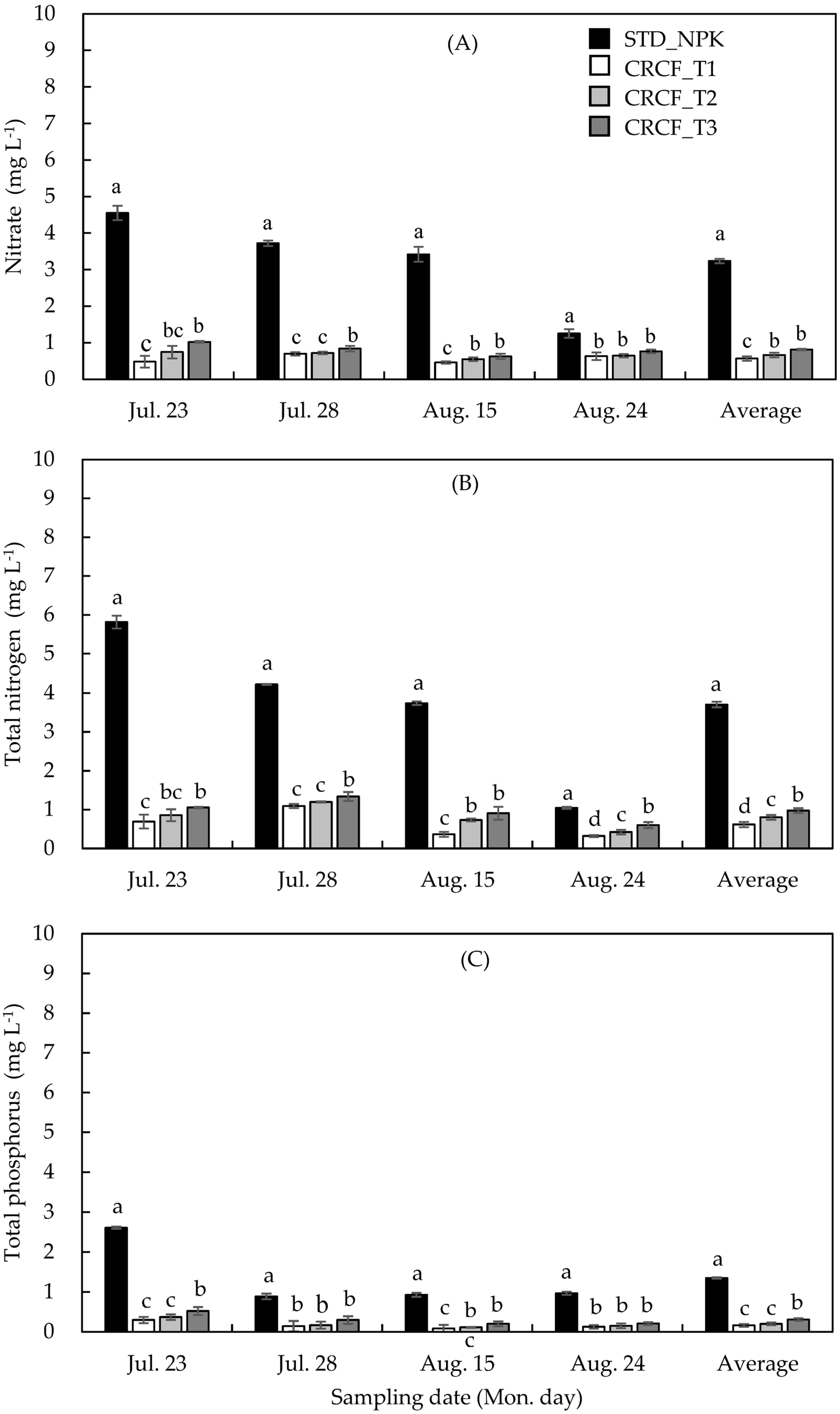Optimizing Nitrogen Use Efficiency and Reducing Nutrient Losses in Maize Using Controlled-Release Coated Fertilizers
Abstract
1. Introduction
2. Materials and Methods
2.1. Site Description
2.2. Crop Cultivation and Experimental Design
2.3. Details of CRCF Fertilizer Used
2.4. Measurement of Nitrogen Use Efficiency
2.5. Estimation of Optimum Nitrogen Rate
2.6. Runoff Collection and Water Quality Analysis
2.7. Statistical Analysis
3. Results
3.1. CRCF Response to the Dried Aboveground Biomass, Fresh Ear Yield, and Nitrogen Use Efficiency
3.2. Optimal Nitrogen Rate for CRCF Application in Maize
3.3. Nutrient Concentrations in Runoff
4. Discussion
4.1. Coating Composition and Nutrient Release Behavior
4.2. Agronomic and Environmental Advantages of CRCF
4.3. Yield Response and Optimal N Rate Determination
4.4. Climate-Smart and Economically Viable Fertilization Strategy
4.5. Comparison with Recent Controlled-Release Technologies
4.6. Limitations of CRCF Under Diverse Climatic and Soil Conditions
5. Conclusions
Author Contributions
Funding
Institutional Review Board Statement
Informed Consent Statement
Data Availability Statement
Acknowledgments
Conflicts of Interest
References
- Follett, R.F.; Hatfield, J.L. Nitrogen in the Environment: Sources, Problems, and Management. Sci. World J. 2001, 1, 920. [Google Scholar] [CrossRef]
- Kondraju, T.; Rajan, K. Excessive fertilizer usage drives agriculture growth but depletes water quality. ISPRS Ann. Photogramm. Remote Sens. Spat. Inf. Sci. 2019, 4, 17–23. [Google Scholar] [CrossRef]
- Galloway, J.N.; Townsend, A.R.; Erisman, J.W.; Bekunda, M.; Cai, Z.; Freney, J.R.; Martinelli, L.A.; Seitzinger, S.P.; Sutton, M.A. Transformation of the nitrogen cycle: Recent trends, questions, and potential solutions. Science 2008, 320, 889–892. [Google Scholar] [CrossRef] [PubMed]
- Mosier, A.; Syers, J.K.; Freney, J.R. Agriculture and the Nitrogen Cycle: Assessing the Impacts of Fertilizer Use on Food Production and the Environment; Island Press: Washington, DC, USA, 2013. [Google Scholar] [CrossRef]
- Naz, M.Y.; Sulaiman, S.A. Slow release coating remedy for nitrogen loss from conventional urea: A review. J. Control. Release 2016, 225, 109–120. [Google Scholar] [CrossRef]
- Wei, Q.; Xu, J.; Liu, Y.; Wang, D.; Chen, S.; Qian, W.; He, M.; Chen, P.; Zhou, X.; Qi, Z. Nitrogen losses from soil as affected by water and fertilizer management under drip irrigation: Development, hotspots and future perspectives. Agric. Water Manag. 2024, 296, 108791. [Google Scholar] [CrossRef]
- Ransom, C.J.; Jolley, V.D.; Blair, T.A.; Sutton, L.E.; Hopkins, B.G. Nitrogen release rates from slow-and controlled-release fertilizers influenced by placement and temperature. PLoS ONE 2020, 15, e0234544. [Google Scholar] [CrossRef]
- Tian, Y.; Yin, B.; Yang, L.; Yin, S.; Zhu, Z. Nitrogen runoff and leaching losses during rice–wheat rotations with conventional and improved fertilizer management. Pedosphere 2007, 120, 248–255. [Google Scholar] [CrossRef]
- Shoji, S.; Delgado, J.; Mosier, A.; Miura, Y. Use of controlled release fertilizers and nitrification inhibitors to increase nitrogen use efficiency and to conserve air and water quality. Commun. Soil Sci. Plant Anal. 2001, 32, 1051–1070. [Google Scholar] [CrossRef]
- Lawrencia, D.; Wong, S.K.; Low, D.Y.S.; Goh, B.H.; Goh, J.K.; Ruktanonchai, U.R.; Soottitantawat, A.; Lee, L.H.; Tang, S.Y. Controlled release fertilizers: A review on coating materials and mechanism of release. Plants 2021, 10, 238. [Google Scholar] [CrossRef]
- Azeem, B.; KuShaari, K.; Man, Z.B.; Basit, A.; Thanh, T.H. Review on materials & methods to produce controlled release coated urea fertilizer. J. Control. Release 2014, 181, 11–21. [Google Scholar] [CrossRef]
- Shaviv, A. Advances in Controlled Release of Fertilizers. Adv. Agron. 2000, 71, 1–49. [Google Scholar] [CrossRef]
- Dovzhenko, A.P.; Yapryntseva, O.A.; Sinyashin, K.O.; Doolotkeldieva, T.; Zairov, R.R. Recent progress in the development of encapsulated fertilizers for time-controlled release. Heliyon 2024, 10, e34895. [Google Scholar] [CrossRef] [PubMed]
- Shoji, S.; Kanno, H. Use of polyolefin-coated fertilizers for increasing fertilizer efficiency and reducing nitrate leaching and nitrous oxide emissions. Fertil. Res. 1994, 39, 147–152. [Google Scholar] [CrossRef]
- Choi, J.M.; Lee, C.W.; Chun, J.P. Optimization of substrate formulation and mineral nutrition during the production of vegetable seedling grafts. Hortic. Environ. Biotechnol. 2012, 53, 212–221. [Google Scholar] [CrossRef]
- Jariwala, H.; Santos, R.M.; Lauzon, J.D.; Dutta, A.; Wai Chiang, Y. Controlled release fertilizers (CRFs) for climate-smart agriculture practices: A comprehensive review. Environ. Sci. Pollut. Res. 2022, 29, 53967–53995. [Google Scholar] [CrossRef]
- Lee, J.H.; Choi, B.R.; Cho, G.G.; Jang, E.K.; Kim, Y.R.; Ji, J.H.; Ku, H.H. Effect of controlled-release coated fertilizer on yield and nitrogen use efficiency in a red pepper cultivated field. J. Soil Sci. Fertil. 2020, 53, 519–527. [Google Scholar] [CrossRef]
- Liu, W.; Xiong, Y.; Xu, X.; Xu, F.; Hussain, S.; Xiong, H.; Yuan, J. Deep placement of controlled-release urea effectively enhanced nitrogen use efficiency and fresh ear yield of sweet corn in fluvo-aquic soil. Sci. Rep. 2019, 9, 20307. [Google Scholar] [CrossRef]
- Meng, T.; Shi, J.; Zhang, X.; Zhao, X.; Zhang, D.; Chen, L.; Lu, Z.; Cheng, Y.; Hao, Y.; Zhao, X.; et al. Slow-release nitrogen fertilizer application regulated rhizosphere microbial diversity to increase maize yield. Front. Plant Sci. 2024, 15, 1481465. [Google Scholar] [CrossRef]
- Morrow, M.; Sharma, V.; Singh, R.K.; Watson, J.A.; Maltais-Landry, G.; Hochmuth, R.C. Impact of Polymer-Coated Controlled-Release Fertilizer on Maize Growth, Production, and Soil Nitrate in Sandy Soils. Agronomy 2025, 15, 455. [Google Scholar] [CrossRef]
- Cameron, K.C.; Di, H.J.; Moir, J.L. Nitrogen losses from the soil/plant system: A review. Ann. Appl. Biol. 2013, 162, 145–173. [Google Scholar] [CrossRef]
- Qiang, S.; Sun, X.; Zhang, Y.; Zhao, H.; Fan, J.; Zhang, F.; Gao, Z. Deep placement of mixed controlled-release and conventional urea improves grain yield, nitrogen use efficiency of rainfed spring maize. Arch. Agron. Soil Sci. 2020, 67, 1848–1858. [Google Scholar] [CrossRef]
- He, J.; Wang, Y.; Li, H.; Ma, J.; Yue, X.; Liang, X.; Hong, Y.; Wang, F.; Hu, C.; Liu, R. Controlled-Release Fertilizer Improving Paddy Yield and Nitrogen Use Efficiency by Reducing Soil Residual Nitrogen and Leaching Losses in the Yellow River Irrigation Area. Plants 2025, 14, 408. [Google Scholar] [CrossRef]
- Ku, H.H.; Hayashi, K.; Agbisit, R.; Villegas-Pangga, G. Effect of rates and sources of nitrogen on rice yield, nitrogen efficiency, and methane emission from irrigated rice cultivation. Arch. Agron. Soil Sci. 2017, 63, 1009–1022. [Google Scholar] [CrossRef]
- Liu, Y.; Ma, C.; Li, G.; Jiang, Y.; Hou, P.; Xue, L.; Yang, L.; Ding, Y. Lower dose of controlled/slow release fertilizer with higher rice yield and N utilization in paddies: Evidence from a meta-analysis. Field Crops Res. 2023, 294, 108879. [Google Scholar] [CrossRef]
- Zhou, L.; Zhao, P.; Chi, Y.; Wang, D.; Wang, P.; Liu, N.; Cai, D.; Wu, Z.; Zhong, N. Controlling the hydrolysis and loss of nitrogen fertilizer (urea) by using a nanocomposite favors plant growth. ChemSusChem 2017, 10, 2068–2079. [Google Scholar] [CrossRef] [PubMed]
- Jia, Y.; Hu, Z.; Ba, Y.; Qi, W. Application of biochar-coated urea controlled loss of fertilizer nitrogen and increased nitrogen use efficiency. Chem. Biol. Technol. Agric. 2021, 8, 3. [Google Scholar] [CrossRef]
- Rafique, M.I.; Al-Wabel, M.I.; Al-Farraj, A.S.; Ahmad, M.; Aouak, T.; Al-Swadi, H.A.; Mousa, M.A. Incorporation of biochar and semi-interpenetrating biopolymer to synthesize new slow release fertilizers and their impact on soil moisture and nutrients availability. Sci. Rep. 2025, 15, 9563. [Google Scholar] [CrossRef]
- Sentek, V.; Velescu, A.; Wilcke, W.; Henke, C.; Peters, N.; Welp, G.; Amelung, W. Nitrogen release from different polymer-coated urea fertilizers in soil is affected by soil properties. Soil Use Manag. 2023, 39, 1477–1490. [Google Scholar] [CrossRef]
- Moradi, S.; Babapoor, A.; Ghanbarlou, S.; Kalashgarani, M.Y.; Salahshoori, I.; Seyfaee, A. Toward a new generation of fertilizers with the approach of controlled-release fertilizers: A review. J. Coat. Technol. Res. 2024, 21, 31–54. [Google Scholar] [CrossRef]




| Year | Texture | pH (1:5) | OM (g kg−1) | NO3−–N (mg kg−1) | Av. P2O5 (mg kg−1) | Exchangeable Cations (cmolc kg−1) | ||
|---|---|---|---|---|---|---|---|---|
| K+ | Ca2+ | Mg2+ | ||||||
| 2017 | Loam | 6.4 | 14 | 26 | 497 | 0.69 | 6.2 | 2.2 |
| 2018 | 6.5 | 13 | 30 | 520 | 0.71 | 6.3 | 2.0 | |
| Treatment | Amount of N–P2O5–K2O Application (kg ha−1) | |||||
|---|---|---|---|---|---|---|
| 2017 Year | 2018 Year | |||||
| N | P2O5 | K2O | N | P2O5 | K2O | |
| None | 0 | 0 | 0 | 0 | 0 | 0 |
| STD_NPK | 150 | 30 | 60 | 150 | 30 | 60 |
| CRCF_T1 | 33.1 | 6 | 8 | - | - | - |
| CRCF_T2 | 49.7 | 9 | 12 | - | - | - |
| CRCF_T3 | 66 | 11 | 16 | 66 | 11 | 16 |
| CRCF_T4 | - | - | - | 80 | 14 | 20 |
| CRCF_T5 | - | - | - | 90 | 16 | 24 |
| Treatment | 2017 | 2018 | ||||||
|---|---|---|---|---|---|---|---|---|
| Above- Ground Biomass | Fresh Ear Yield | N Uptake | NUE | Above- Ground Biomass | Fresh Ear Yield | N Uptake | NUE | |
| (kg ha−1) | (kg ha−1) | (kg ha−1) | (%) | (kg ha−1) | (kg ha−1) | (kg ha−1) | (%) | |
| None | 4603c ± 254 | 4939d ± 117.6 | 16.7 ± 1.5 | - | 4951d ± 163 | 6115c ± 29.3 | 60.3 ± 4.5 | - |
| STD_NPK | 7463a ± 372 | 6830a ± 199.7 | 46.3 ± 1.8 | 20.3c ± 2.5 | 7736a ± 202 | 8201ab ± 1089 | 114.8 ± 8.5 | 36.4c ± 3.4 |
| CRCF_T1 | 6583b ± 340 | 6290c ± 88.9 | 33.7 ± 0.4 | 51.4a ± 4.4 | - | - | ||
| CRCF_T2 | 7273a ± 206 | 6487b ± 87.4 | 39.0 ± 1.4 | 44.8b ± 0.4 | - | - | ||
| CRCF_T3 | 7400a ± 167 | 6862a ± 47.4 | 45.5 ± 3.0 | 43.4b ± 3.4 | 6698c ± 142 | 8001b ± 112.5 | 86.1 ± 5.5 | 78.1a ± 8.1 |
| CRCF_T4 | - | - | 7895a ± 240 | 8680a ± 539.6 | 117.2 ± 9.6 | 71.2a ± 8.2 | ||
| CRCF_T5 | - | - | 7364b ± 182 | 8556a ± 198.8 | 105.9 ± 9.3 | 47.5b ± 10.1 | ||
Disclaimer/Publisher’s Note: The statements, opinions and data contained in all publications are solely those of the individual author(s) and contributor(s) and not of MDPI and/or the editor(s). MDPI and/or the editor(s) disclaim responsibility for any injury to people or property resulting from any ideas, methods, instructions or products referred to in the content. |
© 2025 by the authors. Licensee MDPI, Basel, Switzerland. This article is an open access article distributed under the terms and conditions of the Creative Commons Attribution (CC BY) license (https://creativecommons.org/licenses/by/4.0/).
Share and Cite
Lee, J.-H.; Ku, H.-H. Optimizing Nitrogen Use Efficiency and Reducing Nutrient Losses in Maize Using Controlled-Release Coated Fertilizers. Agrochemicals 2025, 4, 10. https://doi.org/10.3390/agrochemicals4030010
Lee J-H, Ku H-H. Optimizing Nitrogen Use Efficiency and Reducing Nutrient Losses in Maize Using Controlled-Release Coated Fertilizers. Agrochemicals. 2025; 4(3):10. https://doi.org/10.3390/agrochemicals4030010
Chicago/Turabian StyleLee, Jong-Hyeong, and Hyun-Hwoi Ku. 2025. "Optimizing Nitrogen Use Efficiency and Reducing Nutrient Losses in Maize Using Controlled-Release Coated Fertilizers" Agrochemicals 4, no. 3: 10. https://doi.org/10.3390/agrochemicals4030010
APA StyleLee, J.-H., & Ku, H.-H. (2025). Optimizing Nitrogen Use Efficiency and Reducing Nutrient Losses in Maize Using Controlled-Release Coated Fertilizers. Agrochemicals, 4(3), 10. https://doi.org/10.3390/agrochemicals4030010






